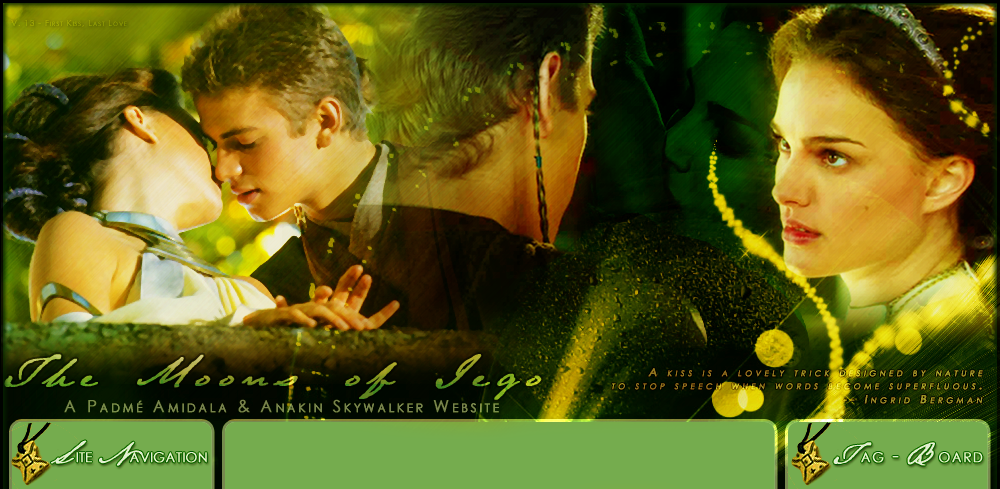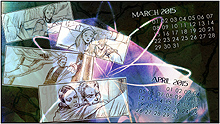



IMAGE |
WALLPAPER |
FAN ART |
FAN FICTION |
Rush by Love and Rock Music. (TCW) The first half of "Destroy Malevolence," as Anakin and Padmé make their way towards each other. |
P/A SITE
|
|
CALENDAR
|
 |

ESSAYS & DISCUSSION
-------------------------------------------
Of Innocence and Experience
by Paul F. McDonald
Published on Suite101.com June 11, 2002
------------------------------
With only one Star Wars film to be completed, fans almost know the entirety of Anakin Skywalker's own hero's journey. Episode Three is admittedly one of the most important pieces of the puzzle, but by now everyone knows enough to realize that his story follows many elements of classical myth quite closely.
As with many mythic heroes, his birth is foretold in prophecy. From an early age, he diplays magical talents and abilities, astounding his contemporaries. As he grows up, he performs all kinds of heroic feats, feats which move to even further his legend. He eventually makes a grand sacrifice at the end of his life, one which ensures his people will triumph against the dark forces which oppose them.
Yet audiences also know that Anakin is Darth Vader, one of the most feared Sith lords in the galaxy. It is a rare thing when the brightest of heroes becomes the darkest of villians, even in myth. His fall to the dark side comes in Episode Three, and while audiences begin to witness some disturbing elements that make up his character in the newest episode, it seems by the end of it he is still a good-hearted Jedi filled with potential.
Attack of the Clones opens with Anakin Skywalker a brash Padawan carrying with him all the trademarks of adolescent angst. Since he began his training at the Jedi Temple very late, it is easy to tell he is something of a wild card for the Order. He will not hesitate to question authority, regardless of whether or not it is an appropriate time. He yearns to progress in his training as fast as anyone will allow. He helplessly swoons over Padmé Amidala, a childhood crush he has yet to get over. He is very much the Jedi version of James Dean, drag-racing airspeeders all over Coruscant, and even occasionally jumping out of them miles up, prompting his master Obi-Wan to scowl like an exasperated father and mutter, "I hate it when he does that."
Easily the most complicated character in the film, his good traits stack up right beside his bad ones. Anakin is enormously talented and obviously already has begun to master the Force, though this is making him a bit too sure of himself for the Jedi Council's tastes. He is brave to the point of being reckless. He is loyal to those he loves almost to a fault, his emotions causing him to get sidetracked from his duty. And like his son Luke when he is told he can't go to Toshi's station to pick up some power converters, he can whine with the best of the Skywalkers.
Some fans have noticed his arrogant, impulsive nature in Attack of the Clones, and have already decided that that is what leads to his inevitable fall. Of course, one could hasten to point out that most adolescent males are arrogant and impulsive. And furthermore, it is safe to say that very few of them become genocidal dictators. It seems to me that after Anakin transforms into Darth Vader, he could have used more of that reckless arrogance. The Emperor clearly has him under his thumb, and as a result, he constantly follows him about saying "Yes, my master" and even telling Luke "I must obey my master." Indeed, perhaps it is actually some last spark of adolescent rebellion that allows him to rise up and finally fulfill his destiny by killing the Emperor.
It is interesting that the boy who is suppose to bring balance to the Force has such a difficult time finding balance in his own self. Myth of course has a heavy psychological component to it, and like most hero archetypes, Anakin is very much a metaphor for a developing consciousness. As he leaves Tatooine and becomes a Jedi, he is really on a tour of self. The Force is likewise symbolic of the unconscious, with all its mystery and uncanny abilities. The Trade Federation ship he blows up in The Phantom Menace and the Sith lord he duels in Attack of the Clones are really symptomatic of all the negative powers he must overcome to be a fully realized human being.
The Swiss psychoanalyst Carl Jung, who did extensive work in the field of mythology, wrote that everyone starts off with an original sense of wholeness. When a self-conscious ego begins to emerge, this wholeness begins to fragment. With Anakin, the process will apparently be traumatic enough to split him into a false persona as Vader. Lucas has told TIME magazine that the real reason Anakin falls to the dark side is that he gets too attached to things. With this inability to let go, he needs all the power he can get, yet the more he tries to control things, the more alienated from them he gets.
There is some great bits of foreshadowing already in place. For one, the scene on Geonosis when Anakin gets his arm welded to a piece of metal on a conveyor belt in the droid factories prefigures his becoming more machine than man, even before he loses his arm completely. There is also his duel with Count Dooku in complete darkness, perhaps symbolizing the role the exiled Jedi will ultimately play in his fall. This scene also ties in with the original trilogy, for Anakin experiences first hand the agony of getting electrocuted by Sith lightning, the very thing that he will later save his son from. The most pivotal scenes of course revolve around his return to Tatooine and his search for his mother.
After Anakin discovers that Shmi has been brutally tortured to death by Tusken Raiders, he gives into his anger and hatred and slaughters the entire tribe. One is reminded of Odysseus in The Odyssey, who likewise returns home after the Trojan war to find his place usurped. And like Anakin, he takes his vengeance on the suitors, killing all of them except one. The eventual consequences in Star Wars will be much more severe, however, as Anakin strives to come to terms with the dark side, the animal, in himself.
In an essay called "Symbolism in the Visual Arts," one of Jung's proteges, Aniela Jaffe, wrote about the significance of animals in dream and myth. Jaffe states that animals often represent repressed facets of the psyche, and that "the acceptance of the animal soul is the condition for wholeness." Animals can be presented as helpful companions, but sometimes they are not. And the more dangerous an animal acts in a dream, the "more imperative is its integration into [the dreamer's] life if some irreparable evil is to be forestalled." This is important to Anakin's journey on all kinds of levels.
In the simultaneously chilling and touching confession to Padmé after taking his revenge on the Tuskens, he furiously states, "They're like animals! And I slaughtered them like animals!" In other words, he matches their savagery, unable to let go and consumed by blood lust. Yet this is not the end of the good Anakin in Attack of the Clones. He seems to earn a bit of a respite later in the film, both physically and psychologically, after Padmé comforts him.
The most prominent visual symbolism for this is when Anakin eventually tames the monstrous Reek in the arena battle. After riding it and being thrown off, he apparently uses the Force to calm the animal, then jumps back on it, and carries Obi-Wan and Padmé away from immediate danger. He tames the negative powers of the wild, abused Reek, and turns them into something positive. Thus he at least temporarily comes to terms with the animal without as well as within.
His respite also comes when Padmé tells him that she "truly, deeply" loves him, and he is willing to let them still be killed in the arena. He does not go into a tantrum or use the dark side of the Force to choke their Geonosian captors. He is willing to go with the situation rather than control it, and while he does argue with Obi-Wan about going back for Padmé when she falls out of the Republic gunship, he eventually concedes and does his duty.
Throughout the film, Anakin is a marvellous character full of conflict and contradiction. By the end of the saga, however, he becomes something of a reconciler. As the incarnation of the Force, he bridges the gap between spirit and matter. As the lover of Padmé, he unites male and female. And as the Chosen One, he even brings together light and dark.
-
<<back to essays & discussion